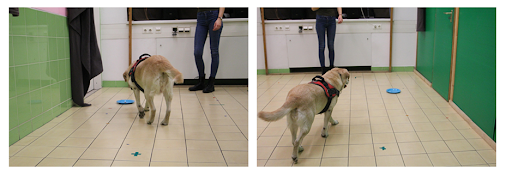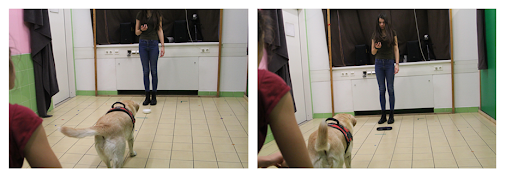While we may never be able to read a dog’s mind, new research indicates that some “smarter” dogs may be able to better interpret where an object is in space. By studying how this phenomenon called spatial bias may reflect what dogs see, researchers could potentially show that dogs process information similarly to the way humans do. The findings are described in a study published November 18 in the journal Ethology.
[Related: Dogs and wolves remember where you hide their food.]
What is spatial bias?
Spatial bias is how the brain processes information related to space, location, or distance when that same information could easily apply to an object.
When a person points to an object, a human toddler will generally focus directly on the object. However, a dog will usually take the gesture as cue to look in that specific direction. This difference is not necessarily due to the dog’s eyesight, but how they think and interpret gestures. Spatial bias is often demonstrated in the difference in how dogs and children react when a person shows them where a toy or treat may be.
“Very early on, children interpret the gesture as pointing to the object, while dogs take the pointing as a directional cue. In other words, regardless of the intention of the person giving the cue, the meaning for children and dogs is different,” study co-author Ivaylo Iotchev said in a statement. Iotchev is a neuroscientist and ethnologist at Eötvös Loránd University in Budapest, Hungary.
Spatial bias has been observed in behavioral tests that show how dogs learn and imitate, but hadn’t been studied until now, according to Iotchev. Earlier studies have not clarified if dogs behave this way due to inferior vision compared to primates, or if it is because the parameters of the space around them are more important to dogs than specific, nearby objects.
In this new study, a team of animal behavior experts was able to gain insight into how some dogs can overcome spatial biases on difficult challenges.
Learning location versus shape and color
The team first tested two behavioral tasks on 82 domestic dogs of varying breeds and sizes. In one task, the dogs had a maximum of 50 trials to learn whether a treat was placed on the right or left side of a plate. This task was designed to teach the dogs about a location when they were directed to find where the treat was.
 Learning about the place: the treat is always on the right or left side only, and the plate on the other side is empty. CREDIT: Eniko Kubinyi.
Learning about the place: the treat is always on the right or left side only, and the plate on the other side is empty. CREDIT: Eniko Kubinyi.
In the second task, the team used a white round plate and a black square one. Both plates were always placed in the middle and a dog was always given only one type of plate to eat from. However, the dog was exposed to each plate in a semi-random sequence, to teach them about the shape and color of the plate. This helped indicate if location or physical properties were easier for the dogs to remember.
 Learning about objects: the treat is always only on the white plate or only on the black plate, the other is empty. CREDIT: Eniko Kubinyi.
Learning about objects: the treat is always only on the white plate or only on the black plate, the other is empty. CREDIT: Eniko Kubinyi.
The team measured learning by how quickly a canine ran to the correct plate. They found that the dogs learned faster when the treat was placed to the right or left of a plate instead of on it.
The dogs appeared to have more difficulty remembering whether the food was on the white round plate or black square one. The ‘spatial bias’ measure indicated that the dogs were learning about a specific place faster than an object’s features like color or shape.
Measuring cognition and vision
A more complicated task looked to see if the dogs had retained the knowledge of where the treat had been placed. If the dog had previously received the treat on the right side of the plate, it was then placed on the left side. If the dog had previously been given the treat on a white plate, it was now on the black plate.
[Related: Do domesticated dogs howl back at wolves?]
To investigate if spatial bias is more sensory, cognitive, or a mixture of both, the team needed to note any differences between the visual and cognitive abilities of different dogs. They measured how short each dog’s head was, since this is correlated with visual acuity. They also observed how efficiently the dogs solved the problems.
“The visual abilities of dog breeds differ from each other, which indirectly results from their head shape. Dogs with shorter heads–scientifically known as brachycephalic–develop human-like vision,” study co-author and PhD student Zsófia Bognár said in a statement. “The structure of their retina implies sharper and more focused vision than their longer-headed counterparts. “
To gauge their cognitive ability, the dogs took part in a series of tests of their memory, attention skills, and perseverance. They found that spatial bias is smaller in dogs with who could see finer details better. According to the team, as human children develop, spatial bias decreases with increasing intelligence and this could be possible for some canines with the right mindset as well.
Earlier studies have shown that for dogs, being “smart” has more to do with its memory than ability to learn new words. The dogs that exhibit characteristics that humans would label as intelligence demonstrated the ability to stick to a more complex task. Understanding how this works can help biologists better understand dogs’ evolution.
“Spatial bias in dogs is not simply a sensory problem but also a mindset. We also found that ‘smarter’ dogs are resilient in difficult learning situations and can overcome their biases,” said Iotchev.

>>> Read full article>>>
Copyright for syndicated content belongs to the linked Source : Popular Science – https://www.popsci.com/environment/why-dogs-usually-cant-tell-what-youre-pointing-at/































